This review covers the single-player game only. Cooperative elements make up at least half the game's content, and all the cooperative test chambers are different from those present in the single player game; this constitutes fully half the game's content. This particular portion of the game will not be covered here; however, all gameplay elements from the single-player mode also apply to the cooperative mode.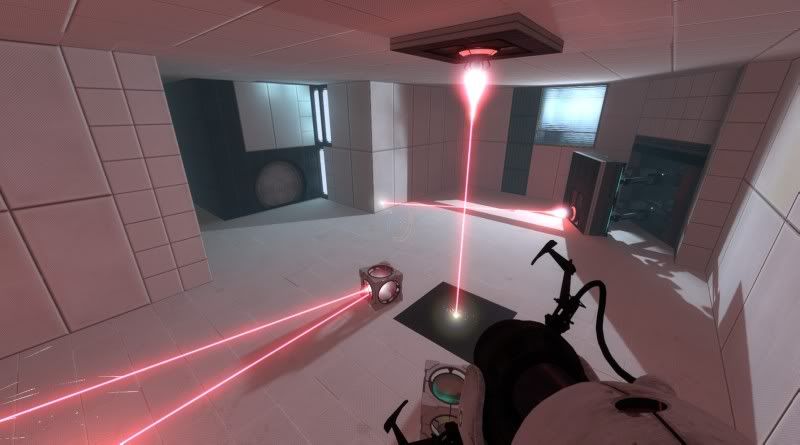 The new Aperture Science Test Chambers look better than ever.
The new Aperture Science Test Chambers look better than ever.So after much fanfare, a huge promotion involving more than a dozen developers, and a communal,
forced PC prerelease of about a third of a day, Portal 2 is here for everyone, and it's bigger and better than anyone could have hoped for. With a slightly longer single-player campaign and a brand-new, completely different (and as long as the single-player game),
cross-platform cooperative play mode, Valve Software has, once again, hit it out of the park with this one.
As many of our readers already know, the original Portal was a surprise smash hit, proving once and for all that the first-person-shooter paradigm doesn't necessarily need to be in the least bit violent or bloody. With its focus on cerebral, mind-bending 'transportation puzzles' (for lack of a better term), Portal was an experiment by Valve that paid off, and paid off
big. In fact, when Valve released the Orange Box, many gamers were pointing to Portal as a justification for buying the package.
I have to confess being quite firmly in that camp. I grew up with video games in my life; my first system was the venerable Atari 2600 when it was in its heyday. I saw the entire industry "grow up"; I've played hundreds of video games in my life, and I have to say beyond any doubt that Valve's Portal comes as close as I've ever seen to a perfect video game. With its wide age appeal, more than occasional deadpan humor, basic nonviolence, and focus on mental challenges, the original Portal stands as a testament to this industry's value as an entertainment medium.
Valve continues to develop that theme in Portal 2. While not
quite as easy to "pick up and play" as the original (the game presents player movement and interaction with the portals a little differently and slightly more opaquely in the sequel), Portal 2 is
definitely more
fun from the beginning, mostly due to that oh-so-rare animal in video games: humor.
THE CHARACTERS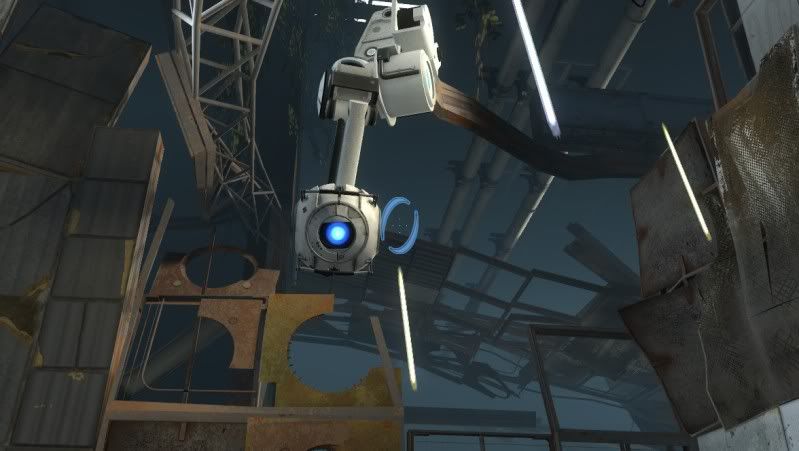 This robot ball has more personality than most human game characters.... no, really.
This robot ball has more personality than most human game characters.... no, really.The robotic AI core pictured above is named Wheatley. He will accompany you throughout the game and delivers some of Portal 2's best lines. He's not too bright, but tries very hard to make up for it. Unfortunately, this usually involves making things worse for you, instead of better. As a character, Wheatley has more personality than pretty much every other human game character on the market, which is quite a feat, given that he has no limbs and no real 'face'. With his sarcastic wit and occasional biting comments, Wheatley is Portal 2's 'fair weather friend'.
From the beginning of the game, Wheatley represents the "essential guide" of the beginning of the game. Thanks to his careful direction, players new to the Aperture Science Enrichment Center will quickly get a feel for movement, direction, and portal placement. Wheatley continues to appear throughout the game and is the only character (apart from GLaDOS herself) that the player interacts with in any way.
 ...we've both said a lot of things you're going to regret...
...we've both said a lot of things you're going to regret...GLaDOS. Insane to begin with, she's even crazier now, and she's after revenge. For those unfamiliar with GLaDOS (an acronym for Genetic Lifeform and Disk Operating System), she's the one in charge of the entire testing facility. As the game is played, GLaDOS will rebuild several of the test chambers around the player, in many cases while the player is there in the testing chamber. I'm not going to say much more about her, mostly because she delivers most of Portal 2's best lines. Suffice to say that the pause button is useful for uncontrollable laughter. Of all the video game villains I've seen, GLaDOS is easily the most hilarious, an accomplishment all by itself considering that most of the time she's nothing but a disembodied voice. Pay attention when she speaks; she will almost always outright lie, but the lulz are
definitely worth it.
 Cave Johnson, CEO of Aperture Laboratories
Cave Johnson, CEO of Aperture LaboratoriesThis is Cave Johnson. First introduced in the promotional material for Portal 2, Cave is responsible for the sheer insanity that takes place in the Enrichment Center. Crass, crude, and with a complete lack of concern for morality, ethics, or safety, Cave's misapplied brilliance and misplaced priorities were the driving force behind the entire operation. Although you won't interact directly with him, his presence during the second half of the game nonetheless fills in Aperture's history (with humor equal to that delivered by GlaDOS) and gives the player a somewhat confused sense of what the Enrichment Center is really about. His more than occasional outright silliness provides a good contrast to the darkly insulting manner of of the game's other characters.
THE MECHANICSAlthough Portal 2 is primarily about, well,
portals, Valve has introduced several new gameplay elements that add new dimensions to the test chambers. What follows is a complete rundown of all the new testing elements you'll encounter as you play Portal 2.
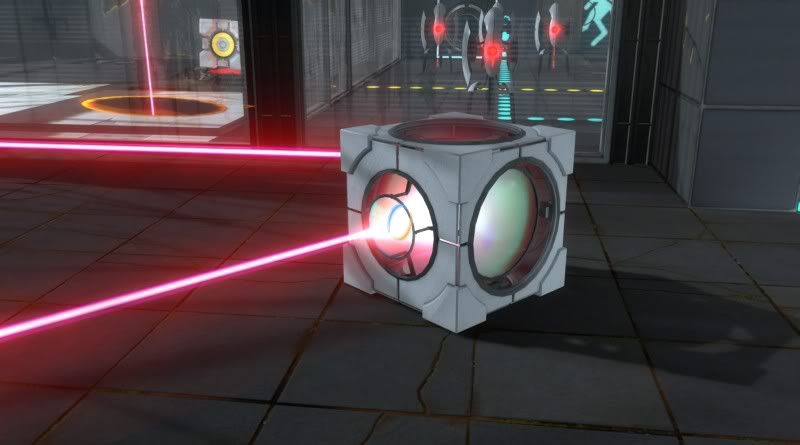 Thermal Discouragement Beam and Redirection Cube
Thermal Discouragement Beam and Redirection CubeThe Aperture Science Thermal Discouragement Beam is a simple laser. Although this laser beam doesn't kill the player, it
is a barrier to movement. You can't simply walk though these, and in fact the player sometimes bounces right off the beam. Be very careful when using these near pits of slime; bumping into one of these beams has dropped me into the drink on more than one occasion.
Fortunately, these beams can be reflected by using the Aperture Science Redirection Cube, also shown. These cubes act like mirrors for the beams, enabling the player to reflect the beams to where they are needed. In all other respects, these are identical to to the Aperture Science Weighted Storage Cube and the Aperture Science Companion Cube; they can be used to knock over turrets and to press the 1500 Megawatt Aperture Science Heavy Duty Super-Colliding Super Button.
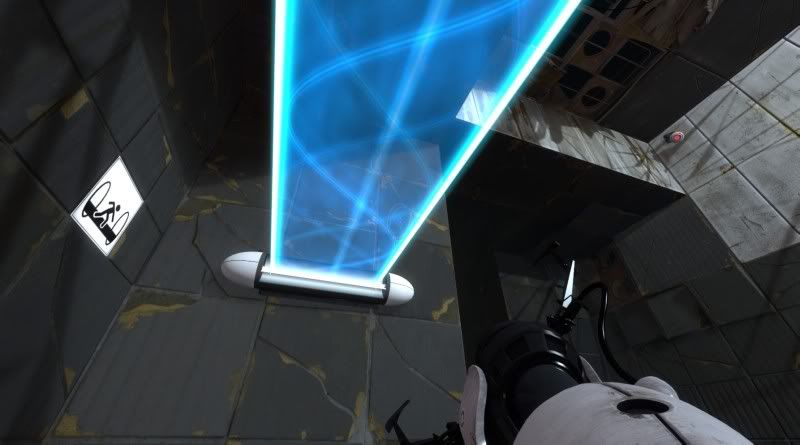 The Aperture Science Hard Light Bridge
The Aperture Science Hard Light BridgeThe Aperture Science Hard Light Bridge is just that: a bridge made of "hard light". These bridges can be extended through any active portal, and you'll use that ability frequently throughout the game. One fun fact that's unmentioned in Portal 2 is that the hard light bridges can also act as impromptu elevators; by repeatedly opening a slightly elevated portal through which a hard light bridge has already extended, it is possible to incrementally raise your character. This isn't
required to solve any particular puzzle, but can nonetheless move your character upward if needed.
 Aperture Science Panel
Aperture Science PanelThe Aperture Science Panel can be concealed within the walls, floors, and ceilings of any given test chamber. Indistinguishable from normal surfaces when inactive, these panels can open new or secret areas, create staircases, and raise or lower ceilings. Thanks to their independent movement, these panels can add flavor animation to a test chamber in addition to being parts of the tests themselves.
 Aperture Science Aerial Faith Plate
Aperture Science Aerial Faith PlateThe Aerial Faith Plate is a special type of panel that acts a bit like a catapult. When the player steps onto one of these, she is immediately flung to the faith plate target, also shown. The trajectory of the player is determined by the plate itself; falling from on high or hitting the plate faster than normal by any other means doesn't seem to affect the plate's force or trajectory. Note that it is possible to fling oneself upward through the ceiling, as suggested in the above image, by placing a portal on the target itself. All the faith plate target surfaces I've found will accept portals, and this characteristic is used on more than one occasion to get you to a place you would otherwise be unable to reach.
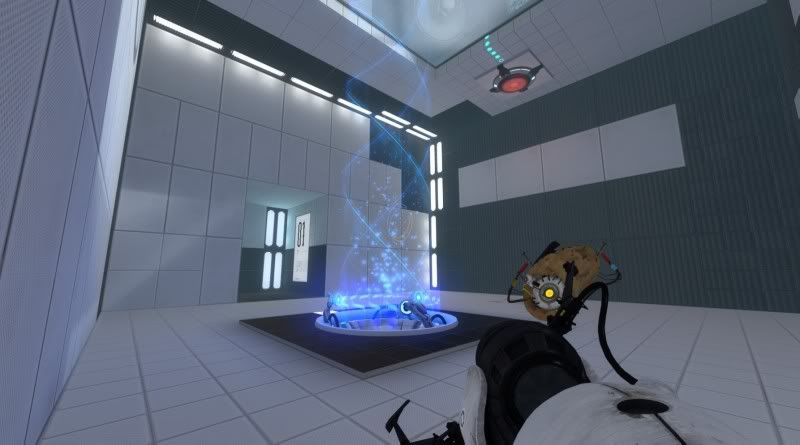 Aperture Science Excursion Funnel
Aperture Science Excursion FunnelThese are made of
liquid asbestos. No,
really. They transport the player and movable objects through them in the direction the funnel travels. As with the light bridges, these funnels extend through open portals. An added feature is that the funnels can change direction, indicated by a color change. Also, as with the light bridges, the player can open a portal beneath the funnel she is traveling in and drop down into the newly-opened portal's excursion funnel. Be very careful when doing this; take note of which portal you're using and which one leads to the funnel emitter or you will very likely take a very painful swim.
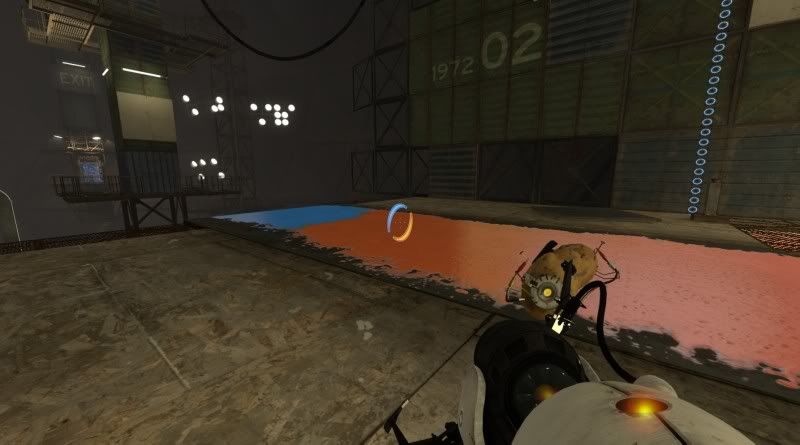 Aperture Science Propulsion Gel and Repulsion Gel
Aperture Science Propulsion Gel and Repulsion GelColored orange and blue, respectively, the propulsion and repulsion gels allow the player to move much faster and jump much higher. Unlike the faith plates, which have a fixed target, the gels only add a movement modifier to normal walking and jumping. These are used to bridge an otherwise insurmountable gap in the player's path or to reach new heights where a faith plate is not present. As with the other new gameplay elements, the gels can be (and often are) used in conjunction with the portals to give an alternative to the "drop from on high" method of gaining altitude using the portals themselves. Placement order is important with these substances, however, as they will overlap their counterpart, painting over any gel of a different color. Thankfully, the gels persist until they are washed away with water (which does happen late in the game) or overridden by another gel.
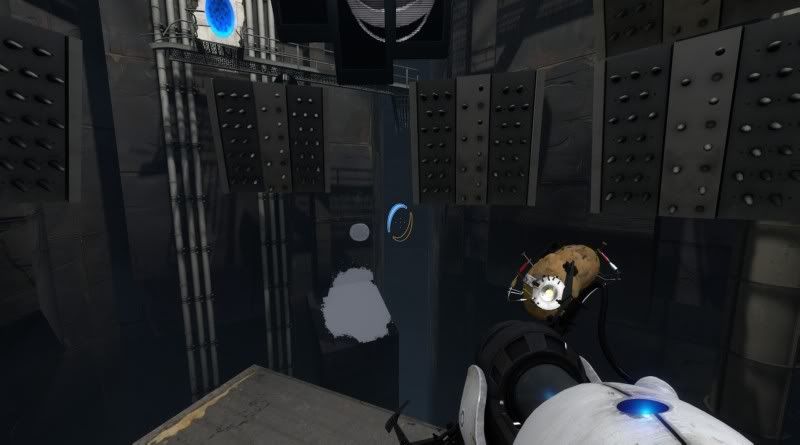 Aperture Science Portal Gel
Aperture Science Portal GelFinally, we have what is possibly the most prosaic of the new game elements: the Aperture Science Portal Gel. This gel, colored white, does what its name implies: when splashed onto any non-portalable surface, this gel makes it portalable. As with the other gels, this can be (and often is) washable with water and can be overwritten by the other two gels. You'll use this gel to great effect right up to the end of the game. For all those moments when you thought to yourself, "I wish I could put a portal there," this is the stuff you want.
<<SCREENSHOT MISSING DUE TO REMOVED GAME ELEMENT>>
Aperture Science Sticky GelRemoved from the game prior to release, the green sticky gel (knowing Cave Johnson, it was probably synthetic snot) would have allowed the player to climb onto walls and ceilings, presumably altering the camera perspective to illustrate the "new floor". Valve may have felt this to be too disorienting and confusing a game element, and made some puzzles too difficult to solve; in any case, it's not there- yet. I hotly dispute this erroneous assumption; gel that changed the camera perspective when standing on it would have only made the game more awesome. I fully expect this substance to make an appearance in user maps created with the SDK.
I only learned about the sticky gel while writing this review, and it represents the
only complaint I have about Portal 2. All in all, the game is at least as good as its predecessor. While not
quite as tightly-wrapped and perfect a package as the original Portal- owing largely to the fact that the portals are only really pure magic once, when a player first picks up either game- Portal 2 represents an industry grand slam nonetheless, and most definitely belongs on the shelf of
any gamer worth her salt.
I've left a
lot out of this review, very much on purpose. There is much,
much more to Portal 2 than what I've revealed here: the origins of Aperture Laboratories, the creation of GLaDOS, and even a hint to a highly-anticipated element of Half Life 2: Episode 3 (or Half Life 3?) are present here. There are laughs to be had (this is the
funniest game to come out in years), puzzles to be solved, a single slice of cake to be had, and
lots of fun for everyone, child to adult.
Final verdict: If you purchase one single top-shelf game this year, you owe it to yourself to make that game Portal 2. Period. This was well worth the wait, totally worth the money, and even though I've finished the single-player element, it'll be on my hard drive for a long time to come.